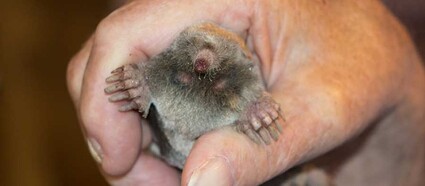Of moles and voles
My wife, Sue, keeps a small lawn in the backyard of our residence at Sun Mountain. She believes a lawn is a wonderful place for grandchildren to play. To keep it healthy, she irrigates, fertilizes and trims it and becomes very upset when one of Nature’s children decides to come and live in?it.
One of the reasons I tolerate lawns is they are magnificent places for dandelions and worms to grow and for a variety of insects to lay eggs which hatch, eat the grass roots and then metamorphose into food for other members of the biomass of our back yard. Also, bees, and just about any pollinator you can think of, just love dandelions.
Looking at this from Sue’s point of view, especially after all the work she goes through keeping the green going, I can understand her annoyance when something gets into her grass — like a pocket gopher.
It isn’t just the grass they eat that gets Sue upset, it’s also the huge mess they make doing so.
However, a soaring hawk — red-tail, Swanson’s, ferruginous or the like — will spot a gopher mound a mile away (literally) and come sailing along watching for the animal to come to the surface.
One thing that brings a gopher to the surface is the condition of their residence. If the hole gets plugged the gopher has to open it quickly to keep air circulating in their home.
Most times a hawk, owl or coyote will snatch a gopher out of its hole when it comes to the surface, and that’s that.
Be that as it may, those mounds are particularly annoying to Sue, so when one appears she gets out her gopher traps and the poor things are soon food for Gary Landers’ raptors at his rehab facility in Sisters.
It took two days, but her recent efforts bore fruit when she saw the trap triggered in her daily, early morning inspections of her gardens and lawn.
As she started for the house to show me the success of her trapping efforts I could see the look of consternation on her face. It didn’t change as she said, “I caught the ‘gopher’ but I don’t think it is. Look at this…,” and she poked it under my nose.
I took one look at the size of the animal, color of the fur, pointed nose, and said, “You’re right that’s not a gopher, it looks more like a mole.”
And by golly, that’s what it’s turned out to be. At first, I thought it was a shrew mole, but size, fur, length of tail and larger-than-life front feet didn’t fit, so I searched through our old friend, Wikipedia, and it turned it into the broad-footed mole pictured above; my first time to ever see one. How about you…?
And then there’s the our native voles. Boy, can they make a nuisance of themselves! In 1958, I had the wonderful experience of being in the community of Alfalfa, east of Bend, every Thursday evening for pinochle and pie at the Grover Place.
In those days there was no such thing as irrigation pivots for hay fields, it was flood irrigation where water was sent from canals then to ditches out to do the job. One Thursday evening, just after dark, Johnny Grover announced he had to go out and “change the water,” and have another piece of pie and pinochle when he got back, and I went along with him.
As we were walking down the lateral between the fields I kept feeling something scrunch under my feet and wondered what in the world I was stepping on. Johnny whipped out his flashlight and shined it on the surface and, lo-and-behold, I was stepping on adult voles scampering about.
When Johnny turned the water into the field it was astonishing to see a sea of fur in the moonlight moving in front of the water, uncountable numbers of voles trying to stay dry.
When they baled the hay in the dark of night, the coyotes would follow the baler, gobbling up voles hiding under the windrow of hay. Then, when the coyotes were full they’d puke up the voles in a pile and go out for more of them. The next day ravens would come by and pig out on the piles of voles.
The most amazing thing was that those same species of voles were in such numbers in the Klamath country that they had actually put a few cattle ranchers out of business. The voles were eating the grass and other forage in such quantities there was nothing left for the?cows.
As it is with boom-bust-species, such as voles and jackrabbits, the next year there wasn’t a vole to be found, which is what we’re seeing this year in the jackrabbits populations — and golden eagles are suffering because of it.
Ahhh, the nature of our Earth, our home away from home. It’s so grand…


















Reader Comments(0)